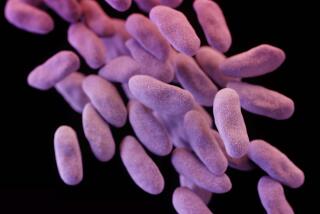Washing Your Underwear? Don’t Forget the Bleach
- Share via
TUCSON, Ariz. — More news from the guy who warned about dangerous germs lurking in your kitchen sponges and dishrags and the muck in your office coffee cup: Your washing machine may not be as safe as you think either.
Environmental microbiologist Charles Gerba spends most of his time researching water quality. But he also enjoys hanging around in other people’s homes, mostly in their bathrooms and kitchens--professionally, of course--searching for environmental hazards. And he finds them in abundance.
For instance, Gerba, a microbiology professor in the University of Arizona’s soil, water and environmental sciences department, warned that bacteria such as E. coli and salmonella can be rampant in kitchen sinks, on counters and on cutting boards, often spread by sponges and dishrags contaminated by meat or poultry.
Or, as he puts it, “There are a hundred times more bacteria on a cutting board than a toilet seat, so lick a toilet seat rather than a cutting board.”
Now he’s found similar dangers in the home laundry.
“It hadn’t been studied in the home very much,” Gerba says. Most laundry studies for the presence of pathogens--disease-causing microorganisms--have been done in hospitals, he says.
His most recent study, of 50 homes in Tucson and 50 others in the Tampa Bay, Fla., area, has found that coliform bacteria, an indicator of unsanitary conditions, including the presence of diarrhea-causing E. coli, abound in many washing machines. Some linger even a load after you’ve washed your underwear, he says.
“They originate in feces, and we found that 60% of the washing machines had coliform bacteria. We just went in and swabbed your washing machine,” Gerba said. “And about 10% had E. coli in it.”
Next, Gerba and his researchers found that 40% of sterile cloths washed in non-bleach laundry contained fecal bacteria.
“We found that when you did clothes with underwear in it, it contaminated all the laundry. In fact, there was enough left over to contaminate the next wash load,” he said.
Bacteria such as salmonella, which causes food poisoning, and viruses including hepatitis A and those that most commonly cause childhood diarrhea, rotavirus and adenovirus, also were targeted.
Although E. coli was killed in the permanent-press drying cycle, some salmonella survived on clothes that registered 131 degrees Fahrenheit. So did hepatitis A, adenovirus and some rotavirus.
Is Gerba painting too foul a picture?
“We don’t think it’s the problem Mr. Gerba does,” said Linda Eggerss, a spokeswoman for the Maytag Corp. of Newton, Iowa, which makes washers and dryers.
“At this point, we might consider it a bit alarmist, because there are so many things so much more dangerous about bacteria around us. We think that washers and dryers are very, very safe and very, very clean, and if you’re using bleach, you can’t get much cleaner than that.”
In February, Procter & Gamble announced a reformulated version of Tide, its top-selling laundry detergent, as a sanitizer with bleach.
“We worked to meet the criteria of the EPA to say that it could sanitize laundry,” spokeswoman Molly Humbert said in Cincinnati. “We’ve heard that consumers are already concerned about bacteria in the laundry. We have data that shows that bacteria can survive the current washing process.”
The key problem is how people launder their clothes today. Most use cold or at most warm water. In fact, industry experts suggest that only 5% of Americans still use hot water for their laundry. And use of bleach is much less routine today than a generation ago.
A national study commissioned for the Oakland, Calif.-based Clorox Co., which makes bleach and financed Gerba’s laundry study, shows that only 15% of all washloads--though half of those with whites--use bleach, spokeswoman Sandy Sullivan said.
What’s more, wash cycles now average about 12 minutes, and dryer cycles average only 28 minutes, Gerba said. That means that some harmful bacteria, and especially viruses, are able to survive the rigors of normal washing and drying. And under the proper conditions, they regrow.
Ingesting 100 to 1,000 pathogenic bacteria can infect someone; it takes only one to 10 viruses to do the same job, Gerba said.
Most of the contamination, and greatest risk, occurs when a person gets bacteria on his hands in transferring the wet laundry to the dryer, he said.
If laundry facilities are next to the kitchen, there’s a good chance that after putting washed laundry in the dryer, the person will prepare food or bring his fingers to nose or mouth. “You contaminate yourself and get the illness from those organisms,” he said.
Gerba will present his findings in June at the American Society for Microbiology’s annual meeting in Chicago.
He said his team usually approaches a major industry player to finance home health hazard studies, and he accepts criticism for his reliance upon such companies to provide grants. The federal government can’t be expected to finance such work, he added.
His findings are published in peer-review journals--he’s written more than 400 papers--and he’s highly regarded within the scientific community. Gerba said it’s important to have studies repeated by others.
Clorox’s Sullivan said there’s an easy solution to the laundry issue.
“At the end of your wash, run an empty cycle and put bleach in. You don’t even need hot water. It’s much like you disinfect your countertops,” she said.
Or, as Gerba calls it, “kind of giving your machine a mouthwash at the end.”






